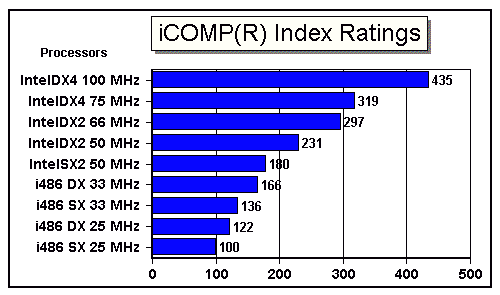
This information is provided for reference only. Not all of the products listed here are currently available through Intel.
For more technical information, please refer to the Embedded Intel Architecture section for developers.
| Processor: | IntelDX4™ Processor | IntelDX2™ Processor | IntelSX2™ Processor | Intel486™ DX Processor | Intel486 SX Processor | ||
|---|---|---|---|---|---|---|---|
| Internal Bus Width: |
up to 128 bits | up to 128 bits | up to 128 bits | up to 128 bits | up to 128 bits | ||
| External Bus Width: |
32 bits | 32 bits | 32 bits | 32 bits | 32 bits | ||
| Virtual Address Space: |
64 Terabytes | 64 Terabytes | 64 Terabytes | 64 Terabytes | 64 Terabytes | ||
| Physical Address Space: |
4 GB | 4 GB | 4 GB | 4 GB | 4 GB | ||
| Clock Frequency: |
75 MHz, 100MHz | 50 MHz, 66MHz | 50MHz | 25MHz, 33MHz, 50MHz |
16MHz, 20MHz, 25MHz, 33MHz |
||
| iCOMP® Rating*: |
319, 435 | 231, 297 | 180 | 122, 166, 249 |
63, 78 100, 136 |
||
| Math Co- processor Support: |
Built-in | Built-in | OverDrive® Processor |
Built-in | None | ||
| First Level Cache Controller: |
16 KB Cache Built-in |
8 KB Cache Built-in |
8 KB Cache Built-in |
8 KB Cache Built-in |
8 KB Cache Built-in |
||
| Voltage: | 3.3 V | 5 V or 3.3 V | 5 Vor 3.3 V | 5 V or 3.3 V | 5 V or 3.3 V | ||
| Manufacturing Process: |
0.6 micron | 0.6 micron | 0.6 micron | 1 micron, 0.8 micron, 0.6 micron |
0.8 micron, 0.6 micron |
||

iCOMP Index stands for the Intel COmparative Microprocessor Performance Index. The iCOMP Index is a weighted average of several industry-standard benchmarks. Each component measures a specific aspect of processor performance, including 16- and 32-bit integer, floating-point, video and graphics capabilities.
*Note: The iCOMP ratings shown have not been updated to the more recent iCOMP Index 2.0 because 486 processors are not measured under the new index. iCOMP Index 2.0 reflects current and emerging 32-bit software and multimedia applications that are designed to take advantage of Pentium, Pentium Pro and future Intel processors. iCOMP Index 2.0 numbers cannot be compared to the original iCOMP Index numbers because different benchmarks and scalings are used.
SPECint92 and SPECfp92 for Mature Intel Processors
Legal stuff